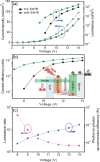SWIR Photodetection and Visualization Realized by Incorporating an Organic SWIR Sensitive Bulk Heterojunction
- PMID: 32714755
- PMCID: PMC7375246
- DOI: 10.1002/advs.202000444
SWIR Photodetection and Visualization Realized by Incorporating an Organic SWIR Sensitive Bulk Heterojunction
Abstract
Short-wavelength infrared (SWIR) photodetection and visualization has profound impacts on different applications. In this work, a large-area organic SWIR photodetector (PD) that is sensitive to SWIR light over a wavelength range from 1000 to 1600 nm and a SWIR visualization device that is capable of upconverting SWIR to visible light are developed. The organic SWIR PD, comprising an organic SWIR sensitive blend of a near-infrared polymer and a nonfullerene n-type small molecule SWIR dye, demonstrates an excellent capability for real-time heart rate monitoring, offering an attractive opportunity for portable and wearable healthcare gadgets. The SWIR-to-visible upconversion device is also demonstrated by monolithic integration of an organic SWIR PD and a perovskite light-emitting diode, converting SWIR (1050 nm) to visible light (516 nm). The most important attribute of the SWIR visualizing device is its solution fabrication capability for large-area SWIR detection and visualization at a low cost. The results are very encouraging, revealing the exciting large-area SWIR photodetection and visualization for a plethora of applications in environmental pollution, surveillance, bioimaging, medical, automotive, food, and wellness monitoring.
Keywords: SWIR photodetection; SWIR visualization; organic photodetectors; solution fabrication.
© 2020 The Authors. Published by WILEY‐VCH Verlag GmbH & Co. KGaA, Weinheim.
Conflict of interest statement
The authors declare no conflict of interest.
Figures






References
-
- Kamimura M., Takahiro S., Yoshida M., Hashimoto Y., Fukushima R., Soga K., Polym. J. 2017, 49, 799.
-
- Jiang Y., Upputuri P. K., Xie C., Zheng Z., Sharma A., Zhen X., Li J., Huang J., Pramanik M., Pu K., Adv. Mater. 2019, 31, 1808166. - PubMed
-
- He S., Song J., Qu J., Cheng Z., Chem. Soc. Rev. 2018, 47, 4258. - PubMed
-
- Miao Q., Pu K., Adv. Mater. 2018, 30, 1801178. - PubMed
LinkOut - more resources
Full Text Sources
Other Literature Sources
